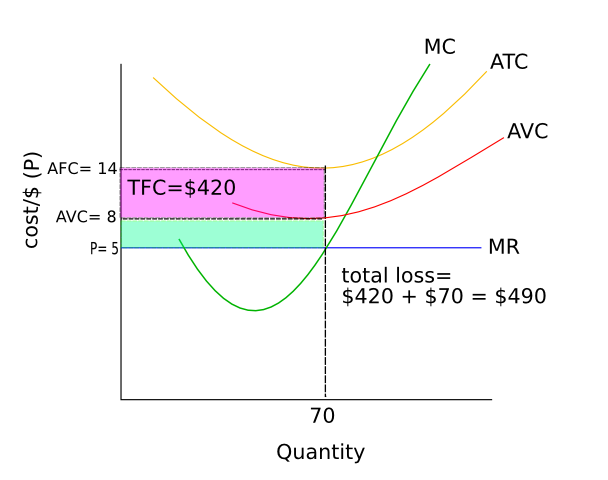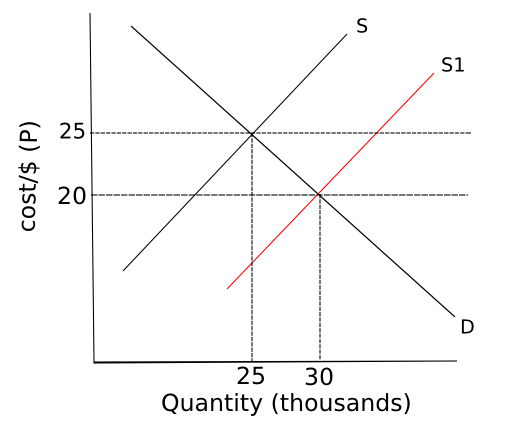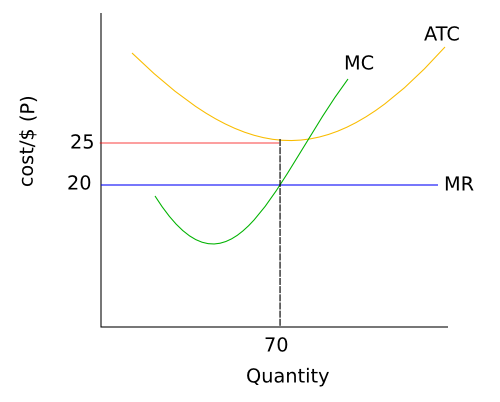
35.) Select a product and create a market supply and demand diagram
- Show the equilibrium price and quantity, and set a binding price ceiling.

Calculate the change in consumer expenditure/producer revenue
The graph above shows the effects of maximum price set for oranges at $1 per oranges. The equilibrium price is $6.00, at which price 2500 kilos of oranges are sold. The price ceiling reduces the price to $3.5, which increases the quantity demanded to 3500 kilos. But at the same time it reduces the quantity supplied to 1500 kilos. Thus at the price-ceiling price, there is excess demand of 2000 kilos.
Consumer expenditure and producer revenue (the same amount in this case) before the price ceiling was $6X2500=$15000. With the price ceiling, consumer expenditure/producer revenue will be $3.5X1500=$5250. Thus, consumer expenditure/producer revenue has fallen by $9750. There is also considerably less oranges sold on the market.
Identify and calculate the government subsidy expenditure needed to eliminate the shortage.
One method to eliminate the shortage is by the government paying subsidies to producers. This subsidy must shift supply far enough to the right to meet the quantity demanded at $3.50, which is 3500 kilos. Therefore it must fill the gap of 2000 kilos.

We can find the per-unit amount necessary to fill the gap by calculating the distance between the old supply curve S, and the new supply curve S (SUB) at 3500 units. In this case, the per-unit amount would be $8.5-$3.5=$5 per unit. The total amount of the subsidy is calculated by multiplying the per-unit amount by the number of units to be subsidized: $5X3500=$17500.
If this method cost too much, the government could directly provide the good. In this case, the government would have to establish its own orange-growing farms. In either case, there would be a significant opportunity cost of allocating government resources.
36.) Select a product and create a market supply and demand diagram.
1. Show the equilibrium price and quantity, and set a binding price floor.

2. Calculate the change in consumer expenditure/producer revenue.
The price floor affected the minimum price for milk set at $9 per litre. The equilibrium price is normally $6, at which price 3000 litres of milk are sold. The price floor raises the price to $9, which increases the quantity supplied to 4500 litres. But at the same time it reduces the quantity demanded to 2500 litres. At the price-floor price, there is an excess supply of 2000 litres.
3. Identify and calculate the government expenditure needed to eliminate the surplus.
Producer revenue/consumer expenditure before the price floor was $6X3000=$18000. Now it is $9X2500=$22500. Milk producer revenue has increased by $4500. The excess supply can be managed in several methods:
- The government could throw out the excess milk. However this method may be politically and ethically displease, and producers might continue losing revenue.
- The government might dump the excess milk to foreign countries. However this is not meant for milk that can be spoiled very quickly, but for storable products such as corn or rice. In addition, the price can get low, but at the same time this method may harm the trading relations.
- The government might buy up the surplus. In this case, the government must pay $9 price floor price. Also they need to buy the amount difference between the new quantity demanded (2500 litres) and supplied (4500 litres) after the price floor was set. Therefore the cost would be $9X2000=18000.
Thus in a situation of price floor, it is also necessary for the government to have a significant opportunity cost for providing other services such as health care and education.
44.) What is the effect of price controls on allocative efficiency?
When a price ceiling is set, it eliminates the allocative efficiency, which is the marginal benefit equaled to marginal cost. The government sets the market price of (in this case) oranges, causing the society not able to produce sufficient amount of oranges to meet the price. Thus a price ceiling cause shortage. In comparison, the price floor causes allocative inefficiency. The high price encourage the producer to produce products at an amount where marginal cost exceeds marginal benefit, beyond the equilibrium. This cause over production or surplus.
46.)Evaluate the effectiveness of rent control.
Rent control is an effect caused by price ceiling, to lower the prise of houses, affordable for low-income citizens. This sounds as a great method, however it causes shortage. By looking at the rules of supply and demand, as the price decline, quantity supplied also decreases. In this case, the reduction of price would lessen the number of house sold. However since the price is cheaper, the demand rises, causing shortage and a shrink in the market. This also causes the quality of the house to fall, because the price is cheap, the total revenue decreases and owners cannot afford to upgrade it. Renters choose to save money rather than spending on improving the house’s safety, weakening the house and unprepared for hazards and disasters. The people who couldn’t buy the house will have less choices because of the price ceiling. Rent control is ineffective because some people chooses to buy houses illegally. For example, in order to definitely get that house, people pay extra money to the renter. In addition, the renter may secretly raise the price so their profit would increase. Illegal action would result in unmanageable rent control for the government. Rent control is a great idea theoretically, however the side effects may affect the borrowers’ lives.
3a.) Explain the concepts of maximum and minimum price controls.
Maximum price control, or price ceiling is a government intervention used when they determine that there is great potential for high prices and makes a goal of keeping prices low. Governments use this procedure to make the good affordable for indigent citizens. However this decreases the market size, because the demand exceeds supply.
Minimum price control, or price floor is when governments raise the price of a good because it is believed to be important or necessary, or it may be supporting employment in a particular industry. Again, this reduces market size because the quantity supplied exceeds quantity demanded and cause a surplus.
3b.) Evaluate the idea that government intervention in the form of price ceilings and price floors is well intentioned, but often leads to undesirable side effects.
Theoretically, the idea to decrease the market price and make the good affordable for poorer inhabitants in price ceiling sounds as well intentioned. Again, the side effects are shortages since the quantity demanded exceeds quantity supplied. Thus individuals illegally purchase that good by paying extra money and creating a black market. This side effect conceals the reality that the government cannot underestimate the shortage and provide a solution. In addition in price floors, it sounds as well intentioned to raise the minimum price of a valuable good and retain it. However price floor causes surplus and a reduction on market size, creating informal markets, where firms choose to sell their surplus at prices below equilibrium. Informal markets contradicts to the ideal aim of keeping valuable goods. Both methods has a solution that the government pays all the shortage and surplus or provide the good to residents. Depending on the good, this decision is politically and ethically outrageous and the solution always have opportunity costs of the government spending money on health and education. As a result the government intervention in the form of price ceilings and price floors is ideally well intentioned, but often leads to undesirable side effects, and an opportunity cost to the government itself to fix it.

 The total fixed cost (TFC) was $420, and the total loss of $490. As a result, the total loss was greater than TFC, thus the firm would shut down before others.
The total fixed cost (TFC) was $420, and the total loss of $490. As a result, the total loss was greater than TFC, thus the firm would shut down before others.































